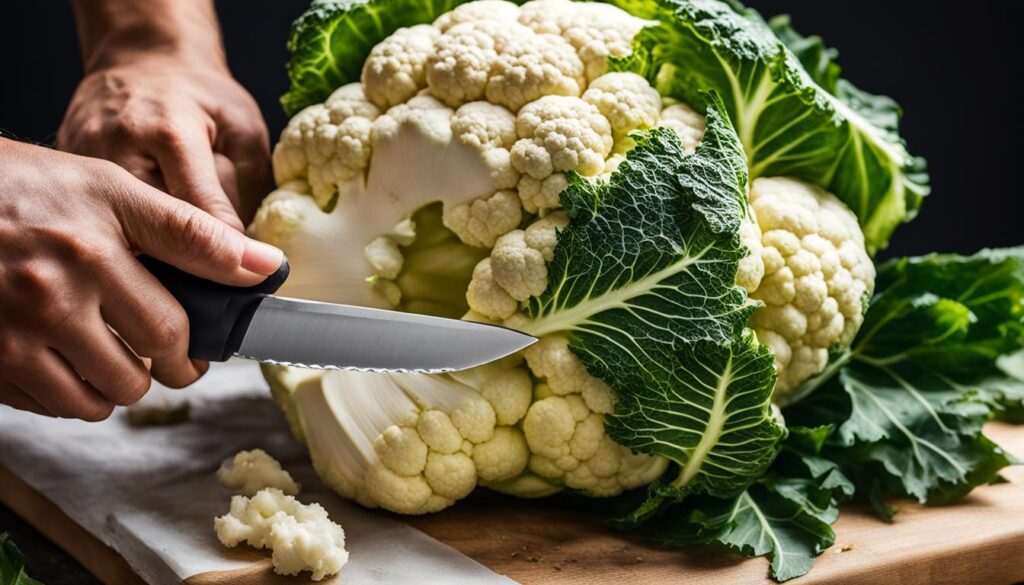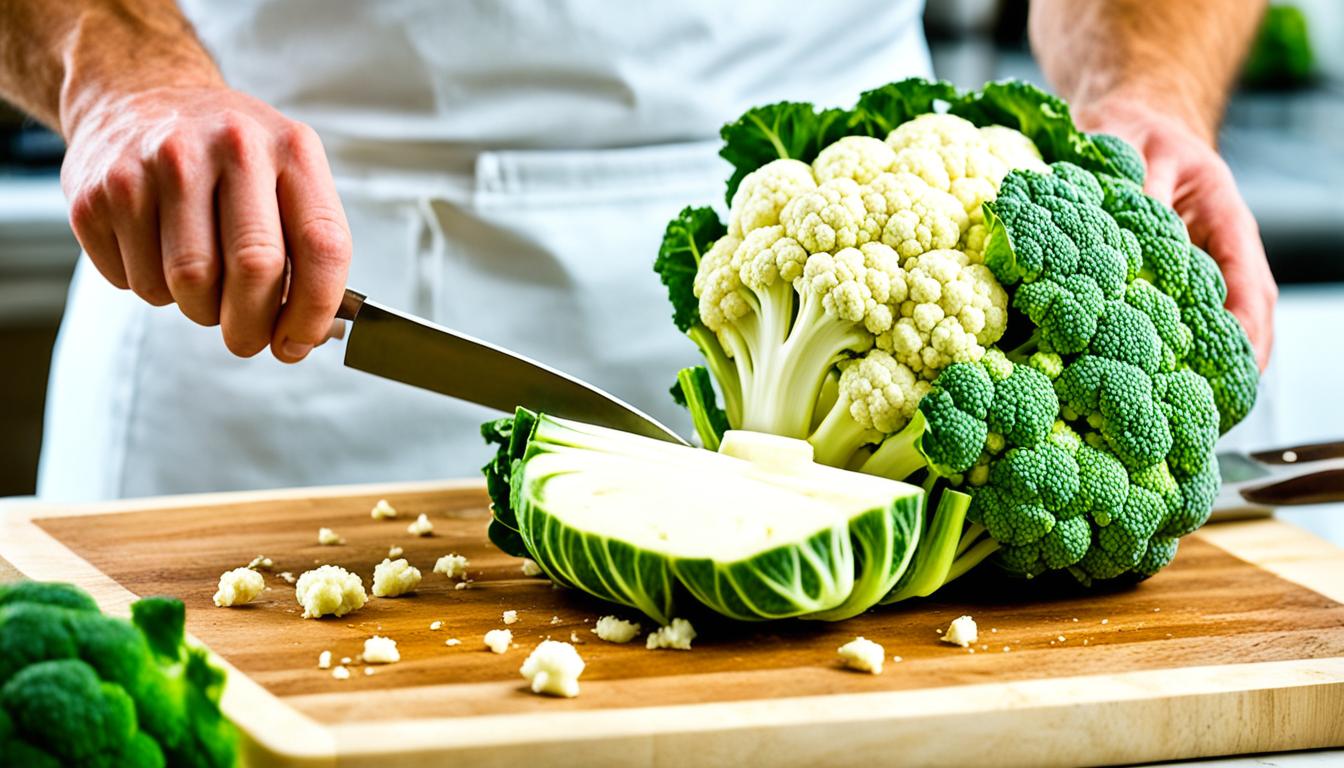Are you tired of struggling to chop cauliflower into neat florets? Wondering if there’s a better way to cut this versatile vegetable? Look no further! In this guide, we’ll reveal the best way to chop cauliflower and cutting techniques that will make the process efficient and hassle-free. Say goodbye to uneven florets and wasted time. Let’s dive in!
Preparing the Cauliflower
Before you can start slicing cauliflower like a pro, it’s important to prepare the cauliflower properly. This will ensure that it’s clean and ready to be used in your favorite recipes.
Removing the Leaves and Trimming the Stem
The first step in preparing cauliflower is to remove the leaves and trim the stem. This can be done easily by holding the cauliflower head firmly and pulling off the leaves from the base. Once the leaves are removed, use a sharp knife to trim the stem, making sure to cut it flush with the base of the cauliflower head.
Rinsing Under Cold Water
After removing the leaves and trimming the stem, rinse the cauliflower under cold water. This will help remove any dirt or debris that may be clinging to the cauliflower. Holding the cauliflower under the running water, gently rub the surface of the cauliflower to ensure that it’s clean. Pat the cauliflower dry with a clean towel before proceeding with the slicing process.
By following these simple steps, you’ll have a clean and well-prepared cauliflower ready to be sliced and cooked. Remember, a well-prepared cauliflower is the key to achieving perfect slices and delicious cauliflower-based dishes.
Cutting Techniques
When it comes to cutting cauliflower, there are different techniques to suit your specific needs. Whether you’re looking to create cauliflower florets, cauliflower steaks, or cauliflower rice, we’ve got you covered with this step-by-step guide.
Cutting Cauliflower Florets
If you want to use cauliflower florets in your recipe, start by cutting off the head from the stem. Then, use your hands or a knife to break apart the florets into bite-sized pieces. This technique is perfect for dishes like stir-fries, soups, and roasted cauliflower.
Cutting Cauliflower Steaks
If you prefer a heartier option, try slicing the cauliflower into thick steaks. Start by cutting the cauliflower head into quarters. Then, slice each quarter into thick slices, about ½ inch thick. This technique works well for grilling, roasting, or even as a vegetarian steak substitute.
Making Cauliflower Rice
If you’re looking for a low-carb alternative to rice, cauliflower rice is the way to go. To make cauliflower rice, start by cutting the cauliflower into small chunks. Then, pulse the cauliflower in a food processor until it resembles rice grains. This technique is perfect for stir-fries, fried rice dishes, and as a base for grain-free bowls.
Remember, the key to cutting cauliflower efficiently is to use a sharp knife and follow these simple step-by-step instructions. With these easy cauliflower cutting tips, you’ll be able to prepare cauliflower for your favorite recipes in no time!
Storing the Cauliflower
After cutting the cauliflower, it’s important to store it properly to maintain its freshness. To store cauliflower effectively, you need an airtight container or ziplock bag. This helps to create a controlled environment that prevents moisture loss and keeps the vegetable from going bad.
Start by placing the cauliflower florets or slices in the container. Ensure they are spread out evenly, allowing for proper air circulation. Next, seal the container tightly to maintain freshness and minimize the risk of exposure to external odors.
To extend the shelf life of cauliflower, store it in the refrigerator. The cool temperature helps to slow down the process of decay and keeps the cauliflower fresh for up to 5 days.
When storing cauliflower, it’s crucial to keep it separate from other foods. Cauliflower has a distinct aroma that can easily transfer to other items in the fridge. By isolating it, you can avoid any unwanted flavor cross-contamination and ensure the cauliflower retains its natural taste.
By following these simple storage steps, you can keep your cauliflower fresh and ready to use whenever you need it. Enjoy its crisp texture and savory flavor in your favorite recipes!
Gather Your Tools
Before you start cutting cauliflower, it’s important to gather the essential tools for the job. Having the right tools on hand will make the cutting process easier and more efficient.
1. Sharp Knife: A sharp knife is crucial for cutting through the dense texture of cauliflower. Opt for a large chef’s knife or a santoku knife, as they provide better control and precision.
2. Cutting Board: Choose a sturdy cutting board that provides a stable surface for cutting. A wooden or plastic cutting board is ideal as it won’t dull your knife and is easy to clean.
3. Bowl or Colander: You’ll need a large bowl or colander to rinse the cauliflower florets after cutting. This will help remove any dirt or debris and ensure clean, fresh-tasting cauliflower.
With these essential tools in your arsenal, you’re ready to tackle cutting cauliflower like a pro!
Now that you have the right tools, it’s time to move on to the next step: removing the leaves and core of the cauliflower.
Removing the Leaves and Core
Before cutting into a cauliflower head, it is important to remove the leaves and core. This ensures that you have a clean and edible cauliflower base to work with. Here’s how to do it:
Removing the Leaves
To remove the leaves, start by holding the cauliflower head firmly on your cutting board. Gently pull the leaves from the base, starting from the outermost leaves and working your way towards the center. Discard the leaves or save them for later use in recipes like soups or stir-fries. Removing the leaves will expose the cauliflower florets, making them easier to cut and cook.
Cutting Out the Core
To remove the core, carefully cut downward from the top of the crown through the stem using a sharp knife. Make a vertical cut, following the natural shape of the cauliflower, until you reach the base. This will remove the tough core from the center of the cauliflower head.
Once the core is removed, cut the cauliflower halves vertically again to further separate the florets. This will give you smaller, bite-sized pieces that are perfect for various cauliflower recipes. Remember to handle the knife and cauliflower with caution to avoid any accidents or injuries.
Cutting the Cauliflower
When it comes to cutting cauliflower, having an efficient cutting technique can save you time and effort in the kitchen. Follow these simple steps to cut cauliflower like a pro.

- Lay a cauliflower quarter on the cutting board: Place one of the cauliflower quarters on the cutting board, ensuring that the stem side faces down.
- Angle the knife to cut out the core: Position the knife at an angle and cut around the core in a circular motion, removing it from the cauliflower quarter.
- Divide the cauliflower into florets: Use your hands or the knife to break apart the cauliflower quarter into smaller, bite-sized florets. If desired, you can cut larger florets into smaller pieces for uniformity.
- Don’t forget the leaves and core: Don’t let anything go to waste! Chop up the cauliflower core and leaves to use in various recipes, such as soups or stir-fries.
By following this efficient cauliflower cutting technique, you’ll be able to prepare cauliflower for your favorite recipes in no time.
Additional Tips for Efficient Cutting
Mastering the art of cutting cauliflower efficiently is key to saving time and achieving clean, precise cuts. Here are some valuable tips to enhance your cauliflower cutting skills:
- 1. Cut the cauliflower head into quarters: Before separating the florets, cut the cauliflower head into quarters. This technique makes it easier to handle and allows for cutting smaller, uniform pieces with greater efficiency.
- 2. Use a sharp knife: Always work with a sharp knife when cutting cauliflower. A sharp blade ensures clean cuts and minimizes the risk of crushing or tearing the florets while slicing through the dense cauliflower head.
By following these efficiency tips for cutting cauliflower and using clean, precise cuts, you’ll be able to prepare cauliflower for your favorite recipes with ease. Remember to prioritize safety by exercising caution when handling sharp knives.
Check out the image below to see a visual representation of these cutting techniques:
Now that you’ve learned the best techniques for cutting cauliflower efficiently, it’s time to explore the various possibilities this versatile vegetable offers in the kitchen. Section 9 will guide you through exciting cauliflower recipes that will take your culinary skills to the next level!
Exploring Cauliflower’s Possibilities
Cutting cauliflower opens up a world of possibilities in the kitchen. This versatile vegetable can be transformed into a variety of delicious and nutritious dishes, allowing you to explore new flavors and culinary experiences.
One of the most popular ways to cook cauliflower is to make a cauliflower stir-fry. By cutting the cauliflower into small florets, you can quickly sauté it with your favorite vegetables and seasonings for a healthy and satisfying meal. The mild flavor of cauliflower pairs well with various sauces and spices, giving you endless options to create different flavor profiles.
Another option is to roast cauliflower. By cutting it into larger florets or even cauliflower steaks, you can achieve a crispy and caramelized texture that brings out the natural sweetness of the vegetable. Roasted cauliflower can be enjoyed as a side dish or used as a topping for salads, pizzas, and grain bowls.
If you’re looking for a healthier alternative to traditional pizza crust, cutting cauliflower into small pieces and using it as the base for a cauliflower pizza crust is a great option. By combining cauliflower with eggs, cheese, and other ingredients, you can create a delicious low-carb and gluten-free crust that can be topped with your favorite pizza toppings.
So, don’t limit yourself when cooking with cauliflower. With its versatility and the right cutting techniques, you can unleash your creativity in the kitchen and discover a whole new world of cauliflower recipes. Whether you’re a novice or an experienced chef, experimenting with cauliflower will not only expand your culinary repertoire, but also provide you with nourishing and flavorful dishes to enjoy.
